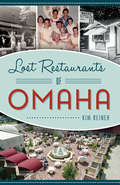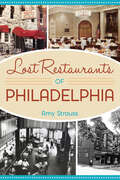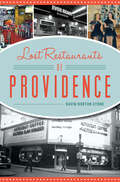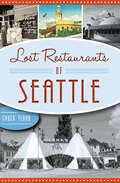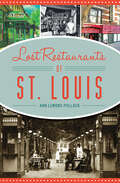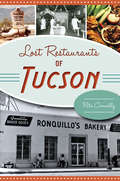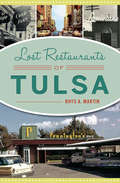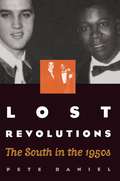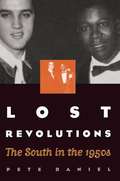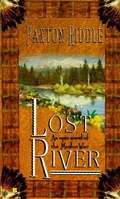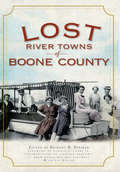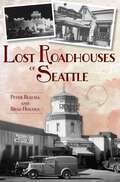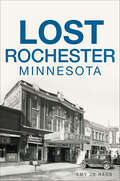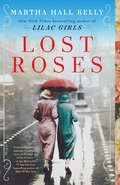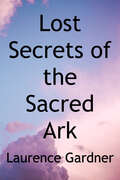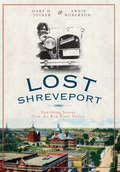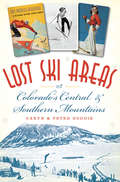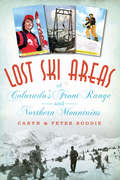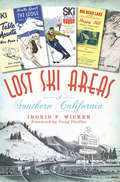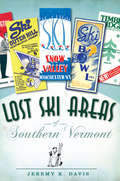- Table View
- List View
Lost Restaurants of Omaha (American Palate)
by Kim ReinerOmaha is known for its beef, but the history of its most famous restaurants goes far beyond. The French Café was the place to go to celebrate. Piccolo Pete's, Mister C's and Bohemian Café helped shape neighborhoods in Little Italy, North Omaha and Little Bohemia. The tales of restaurateurs like the tragic Tolf Hanson; the ever-optimistic Ross Lorello; Anthony Oddo, once a resident at Boys Town; and Giuseppa Marcuzzo, a former bootlegger, also tell the story of the city. Restaurants played a prominent role as history unfolded in Omaha during prohibition, wartime rations, the fight for equal rights and westward expansion. Author Kim Reiner details the fascinating history behind Omaha's classic eateries.
Lost Restaurants of Philadelphia (American Palate)
by Amy StraussCulinary Memories from Philadelphia's Past...Beyond the Cheesesteak Long before Philadelphia's food scene was splashed on covers of Bon Appetit and local establishments garnered accolades like "America's best restaurant," culinary pioneers set the city's restaurant industry ablaze. Frenchman Georges Perrier brought the city the highest, most-respected opulence, Le Bec-Fin, for 40 years running. The ultimate seafood institute, Old Original Bookbinder's, held the title of the world's largest lobster tank and prepared impeccable oyster Rockefeller. Steve Poses changed the culinary game with the Frog that captivated palates with the infusion of international flavors. The nation's very first automat, Horn & Hardart's, consistently delivered near-perfect comfort food classics via vending machine. Amy Strauss revisits celebrated spaces, unforgettable personalities and must-have recipes that made Philadelphia's historic restaurants remembered for their delicious moments in time.
Lost Restaurants of Providence (American Palate)
by David Norton StoneA culinary history of Providence and the memorable eateries that once made their homes there. In the city that invented the diner, so many amazing restaurants remain only in memories. The Silver Top had fresh coffee every twenty minutes, and the Ever Ready was hot dog heaven. Miss Dutton's Green Room and the Shepard Tea Room beckoned shoppers in their Sunday finest. At Childs, the griddle chef made butter cakes in the window for night owls, and Harry Houdini supped at midnight with H.P. Lovecraft at the Waldorf Lunch. Themed lounges like the Beachcomber and the Bacchante Room chased away the Prohibition blues. Downcity Diner offered a famous meatloaf, and Ming Garden&’s Ming Wings were a staple for regulars. Author David Norton Stone details the restaurants that still hold a place in the hearts of locals
Lost Restaurants of Sacramento and Their Recipes (American Palate)
by Maryellen Burns Keith BurnsFrom saloons and tamale vendors to greasy spoons and neon-lit drive-ins, Sacramento natives Maryellen Burns and Keith Burns trace the trends of California's capital city through 150 years of dining out. Share in the delicious anecdotes and recipes gathered from restaurant owners, employees and patrons as they recall Sacramento's favorite places to eat--a century of Hangtown Fry served at the Saddle Rock, crispy won ton dunked in red sauce at the Hong Kong Cafe, pineapple spare ribs with Mai Tais at Maleville's Coral Reef and burgers and sundaes devoured at Stan's Drive-In. Savor these stories of the ambiance, the service and the grub that created lasting memories and drew crowds, decade after decade, to Sacramento's iconic restaurants.
Lost Restaurants of Seattle (American Palate Ser.)
by Chuck FloodAn expert in Americana explores the legendary eateries of Seattle&’s past, from culinary pioneers to neighborhood haunts, roadside diners, and more. From the nineteenth century to today, Seattle has been home to some of the finest oyster houses, dining rooms, and lunch counters in America. It has seen them come and, in many cases, watched them go. In Lost Restaurants of Seattle, author Chuck Flood celebrates nearly a thousand of Seattle's vanished eateries, along with a few resilient survivors. Exploring their cuisines and recipes, Flood tells of how Manca's Café invented the irresistible Dutch Baby pancake, while Trader Vic's gained reverence for its legendary Mai Tais. And with wonderful historic images, she shows why places like the railroad car–themed Andy's Diner and the Twin T-P's with its iconic wigwam-shaped dining rooms live on in the city's culinary memory long after their departure.
Lost Restaurants of St. Louis (American Palate Ser.)
by Ann Lemons PollackA culinary history of the Gateway City and the memorable restaurants that once made their home there.St. Louis is a food town, and there are many restaurants that have captured the heart of the city. Some of them are no longer around. Rossino&’s low ceilings and even lower pipes didn&’t stop the pizza-hungry residents from crowding in. Jefferson Avenue Boarding House served elegant &“Granny Food&” in plush surroundings. King Burgers and onion rings ruled at the Parkmoor. Dohack&’s claimed it was the first to name the &“jack salmon.&” Author Ann Lemons Pollack details these and more restaurants lost to time in the Gateway City.&“Few St. Louisans know the history of the St. Louis food scene like local food and travel writer Ann Lemons Pollack. . . . The book is a treasure trove for St. Louis history-lovers, beginning with an extensively researched look at the food served at the 1904 Louisiana Purchase Exposition—better known as the 1904 World&’s Fair—hosted in St. Louis. She debunks some myths—hot dogs were not &“invented&” at the fair, but perhaps found a wide audience there—and charts the various restaurants and cafes that fed eager fairgoers.&”—Feast Magazine
Lost Restaurants of Tucson (American Palate)
by Rita ConnellyFrom western roadhouses to fine dining, Tucson boasts an extraordinary lineup of diverse restaurants. Though some of its greatest no longer exist, their stories conjure the sights, smells and sounds of the city's history. Longtime locals still buzz about Gordo's famous chimichangas, an accidental dish originating in Tucson. The legendary Tack Room was a beacon of fine dining. Places like Café Terra Cotta and Fuego pioneered a new southwestern cuisine, serving regional dishes like prickly pear pork and stuffed poblanos. University of Arizona alumni miss old spots like the Varsity, while long-gone haunts like Gus & Andy's attracted a unique crowd of businessmen, movie stars and the occasional mobster. Join local food writer Rita Connelly as she serves up savory stories of good food and good company from the gone but never forgotten favorites of the Old Pueblo.
Lost Restaurants of Tulsa (American Palate)
by Rhys A. MartinIn the early twentieth century, Tulsa was the "Oil Capital of the World." The rush of roughnecks and oil barons built a culinary foundation that not only provided traditional food and diner fare but also inspired upper-class experiences and international cuisine. Tulsans could reserve a candlelit dinner at the Louisiane or cruise along the Restless Ribbon with a pit stop at Pennington s. Generations of regulars depended on family-owned establishments such as Villa Venice, The Golden Drumstick and St. Michael's Alley. Join author Rhys Martin on a gastronomic journey through time, from the Great Depression to the days of "Liquor by the Wink" and the Oil Bust of the 1980s.
Lost Restaurants of Tulsa (American Palate)
by Rhys A. MartinIn the early twentieth century, Tulsa was the "Oil Capital of the World." The rush of roughnecks and oil barons built a culinary foundation that not only provided traditional food and diner fare but also inspired upper-class experiences and international cuisine. Tulsans could reserve a candlelit dinner at the Louisiane or cruise along the Restless Ribbon with a pit stop at Pennington's. Generations of regulars depended on family-owned establishments such as Villa Venice, The Golden Drumstick and St. Michael's Alley. Join author Rhys Martin on a gastronomic journey through time, from the Great Depression to the days of "Liquor by the Wink" and the Oil Bust of the 1980s.
Lost Restaurants of Walla Walla (American Palate)
by Catie McIntyre WalkerDining in Walla Walla blossomed from an influx of mining transplants in the late 1800s. Within decades, a roadhouse called the Oasis boasted a seventy-two-ounce slab of beef, and the old Pastime Café opened at 5:30 a.m. with white toast and whiskey for breakfast. In the early 1950s, Ysidro Berrones opened one of the valley's first Mexican restaurants, the El Sombrero Tortilla Factory and Café. Owner of Denney's Hi-Spot for two decades, Joe Denney also satisfied locals with his morning crooning to piano on KTEL. Native and local wine writer Catie McIntyre Walker celebrates this rich heritage with decades of departed, beloved establishments and the people behind them.
Lost Revolutions
by Pete DanielThis sweeping work of cultural history explores a time of startling turbulence and change in the South, years that have often been dismissed as placid and dull. In the wake of World War II, southerners anticipated a peaceful and prosperous future, but as Pete Daniel demonstrates, the road into the 1950s took some unexpected turns.Daniel chronicles the myriad forces that turned the world southerners had known upside down in the postwar period. In chapters that explore such subjects as the civil rights movement, segregation, and school integration; the breakdown of traditional agriculture and the ensuing rural-urban migration; gay and lesbian life; and the emergence of rock 'n' roll music and stock car racing, as well as the triumph of working-class culture, he reveals that the 1950s South was a place with the potential for revolutionary change. In the end, however, the chance for significant transformation was squandered, Daniel argues. One can only imagine how different southern history might have been if politicians, the press, the clergy, and local leaders had supported democratic reforms that bestowed full citizenship on African Americans--and how little would have been accomplished if a handful of blacks and whites had not taken risks to bring about the changes that did come.
Lost Revolutions: The South in the 1950s
by Pete DanielLost opportunities littered the southern landscape in the years between World War II and Freedom Summer. One can only imagine how different southern history might have been if politicians, the press, the clergy, and local leaders had supported democratic reforms that bestowed full citizenship on African Americans. And one can only imagine how little would have been accomplished if a handful of blacks and whites had not taken risks to bring about the changes that did come.
Lost Rights: The Misadventures of a Stolen American Relic
by David HowardNear the close of the Civil War, as General Sherman blazed his path to the sea, an unknown infantryman rifled through the North Carolina state house.The soldier was hunting for simple Confederate mementos—maps, flags, official correspondence—but he wound up discovering something far more valuable. He headed home to Ohio with one of the touchstones of our republic: one of the fourteen original copies of the Bill of Rights. Lost Rights follows that document’s singular passage over the course of 138 years, beginning with the Indiana businessman who purchased the looted parchment for five dollars, then wending its way through the exclusive and shadowy world of high-end antiquities—a world populated by obsessive archivists, oddball collectors, forgers, and thieves— and ending dramatically with the FBI sting that brought the parchment back into the hands of the government. For fans of The Billionaire’s Vinegar and The Lost Painting, Lost Rights is “a tour de force of antiquarian sleuthing” (Hampton Sides).
Lost River
by Paxton RiddleIn 1860s Oregon Territory, tensions run high between the Modoc tribe and the white settlers. While each group's leaders strive for peace, some on both sides want only blood. In this deadly landscape, two lovers-- a white man and an Indian princess--are caught between loyalty and the unbreakable bonds of love.
Lost River Towns of Boone County
by Melinda Sartwell C. Adam Harke Jennifer Gregory Donald E. Clare Jr. Bridget B. StrikerWhen Boone County was officially founded in 1799, a local population was already growing by the day. The Ohio River offered settlers access to this new frontier west of the Alleghenies, and soon many vibrant communities were established along the banks of the Ohio. Today, once thriving towns like North Bend, Belleview and Touseytown, built to last through generations, have all but vanished. The unforgiving current of the Ohio River washed many away, while modern transportation construction dispatched the remaining towns. Fortunately, through the efforts of editor Bridget Striker and a skilled team of local historians and archivists at the Boone County Public Library, these sunken homesteads have been unearthed. Peer into a bygone way of life through this comprehensive collection of vintage photographs and engaging historical accounts.
Lost Roadhouses of Seattle (American Palate)
by Brad Holden Peter BlechaProhibition came early to Washington State--in 1916--and kicked off an unforgettable era of nightlife.Prohibition went national in 1920 and a network of roadside inns, taverns and dancehalls just outside of Seattle's city limits thrived well into the rockin' 1950s, providing illicit entertainment for those seeking a good time. Spurred on by early car culture and strict liquor laws, places like the Spanish Castle, The Jungle and The Black Cat sprang into being. Commonly called roadhouses, many of these remote outposts existed along two newly-built and parallel stretches of county highways - far from the prying eyes of city police. Fabled speakeasy operator, "Doc" Hamilton founded some of the earliest of these hideaways.Join authors Peter Blecha and Brad Holden as they uncover the fascinating era of forbidden nightclubs.
Lost Rochester, Minnesota (Lost)
by Amy Jo HahnRochester is synonymous with one of its most famous landmarks, the Mayo Clinic, but there's so much more to the Med City. It began as a frontier town, struggling to make its mark in a sparsely populated wilderness. By the late nineteenth century, Rochester had expanded into a vibrant city, rich with business, educational and cultural opportunities. Rediscover the Dubuque Trail and the beautiful summer lake retreats, along with the Cook Hotel, the Central Fire Station and more. Author Amy Jo Hahn uncovers the lost beginnings of Rochester and brings the stories of this unique place to life.
Lost Roses: A Novel (Woolsey-Ferriday)
by Martha Hall KellyThe million-copy bestseller Lilac Girls introduced the real-life heroine Caroline Ferriday. Now Lost Roses, set a generation earlier and also inspired by true events, features Caroline’s mother, Eliza, and follows three equally indomitable women from St. Petersburg to Paris under the shadow of World War I. <P><P> It is 1914, and the world has been on the brink of war so often, many New Yorkers treat the subject with only passing interest. Eliza Ferriday is thrilled to be traveling to St. Petersburg with Sofya Streshnayva, a cousin of the Romanovs. The two met years ago one summer in Paris and became close confidantes. <P><P>Now Eliza embarks on the trip of a lifetime, home with Sofya to see the splendors of Russia: the church with the interior covered in jeweled mosaics, the Rembrandts at the tsar’s Winter Palace, the famous ballet. But when Austria declares war on Serbia and Russia’s imperial dynasty begins to fall, Eliza escapes back to America, while Sofya and her family flee to their country estate. <P><P>In need of domestic help, they hire the local fortune-teller’s daughter, Varinka, unknowingly bringing intense danger into their household. On the other side of the Atlantic, Eliza is doing her part to help the White Russian families find safety as they escape the revolution. But when Sofya’s letters suddenly stop coming, she fears the worst for her best friend. <P><P>From the turbulent streets of St. Petersburg and aristocratic countryside estates to the avenues of Paris where a society of fallen Russian émigrés live to the mansions of Long Island, the lives of Eliza, Sofya, and Varinka will intersect in profound ways. In her newest powerful tale told through female-driven perspectives, Martha Hall Kelly celebrates the unbreakable bonds of women’s friendship, especially during the darkest days of history. <P><b>A New York Times Bestseller</b>
Lost Sandusky (Lost)
by M. Kristina SmithSANDUSKY BUILT ITS REPUTATION on the appeal of a picturesque lakefront and the opportunities of a manufacturing hub. Not only did its factories keep pace with the transportation industry, but the Ohio city also boasted the headquarters of international paper maker Hinde and Dauch and enough crayon production to be called the "Color Capital of the World." The amusement park at Cedar Point helped launch a new form of entertainment that continues today. But while the town remains a vacation destination and retains some heavy industry, it misses much of its former glory. Join M. Kristina Smith in revisiting those landmarks of Sandusky's past.
Lost Secrets of the Sacred Ark: Amazing Revelations of the Incredible Power of Gold
by Laurence GardnerThis book is by the bestselling author of Bloodline of the Holy Grail. From the tombs of pharaonic Egypt, to the laboratories of modern science, comes the extraordinary account of gravity defiance and teleportation in the ancient world, and amazing revelations about the past power and future significance of the sacred Ark.
Lost Shreveport: Vanishing Scenes from the Red River Valley (Lost)
by Gary D. Joiner Ernie RobersonNavigating Louisiana's Red River in 1830 was an extremely treacherous task. Only after Captain Henry Miller Shreve removed "The Great Raft," the giant logjam clogging over one hundred miles of river, could the frontier outpost of Shreveport begin to thrive. Over the course of many decades, the city of Shreveport witnessed dramatic growth and ever-changing landscapes. Mule-drawn railways gave way to electric streetcars, and what was once the Confederate capital of the state became today's vibrant commercial hub of northwest Louisiana. Drawing from their extensive image collection, authors Joiner and Roberson depict the disappearing scenes and lost stories that form the complex layers of Shreveport history. From the famous performances of Pawnee Bill s Wild West Show to the infamous red-light district, from the decline of vigilante justice to the victims who perished from yellow fever, Joiner and Roberson recover and remember lost Shreveport.
Lost Ski Areas of Colorado's Central and Southern Mountains
by Peter Boddie Caryn BoddieColorado's central and southern mountains still draw droves of skiers to the slopes. However, many of the historic runs and areas that were popular over the past century--some near the current resorts of Aspen, Breckenridge, Crested Butte, Purgatory, Telluride and Vail--no longer exist. Local hills like Whittaker Ranch near Eagle featured little more than a rope tow and warming hut. Now underneath Lake Dillon, Prestrud Jump hosted tournaments where Olympian Anders Haugen broke ski-jumping world records. From Lands End near Grand Junction to Sugarite near Trinidad, from swanky Hoosier Pass in Summit County to Stoner in Montezuma County, authors Caryn and Peter Boddie take readers on a tour of the lost ski areas of central and southern Colorado.
Lost Ski Areas of Colorado's Front Range and Northern Mountains (Lost)
by Peter Boddie Caryn BoddieAvid skiers have flocked to the northern reaches of the Centennial State for over a century. While the prized powder remains the same, the top skiing destinations bear only a faint resemblance to the resorts of previous generations. Neighborhood slopes, such as Tabernash Hill, featured little more than a rope tow and a storage shed. Other spots like Estes Park's Old Man Mountain held tournaments and contests with Olympic participants. From the Cathy Cisar Winter Playground in Craig to Cheyenne Mountain's Ski Broadmoor and everywhere in between, join authors Caryn and Peter Boddie on a tour through the lost ski areas of northern Colorado and the Front Range.
Lost Ski Areas of Southern California (Lost)
by Ingrid P. Wicken Doug PfeifferThe snow-laden slopes of the San Bernardino and San Gabriel Mountains have beckoned Southland skiers since the 1930s. Many once-cherished ski areas have disappeared, yet their history remains. A short drive from the sun and sand, places like Rebel Ridge and Kratka Ridge offered snowy escapes. Thrilling races were held at the First International Pine Needle Ski Tournament in North Hollywood, while the San Diego Ski Club boasted Dorothy McClung Wullich, the first female member of the National Ski Patrol. Ingrid Wicken, ski historian and founder of the California Ski Library, chronicles Southern California's lost mountain getaways and the vanished ski areas that introduced everything from rope tows to artificial snow.
Lost Ski Areas of Southern Vermont
by Jeremy K. DavisHidden amongst the hills and mountains of southern Vermont are the remnants of sixty former ski areas, their slopes returning to forest and their lifts decaying. Today, only fourteen remain open and active in southern Vermont. Though they offer some incredible skiing, most lack the intimate, local feel of these lost ski trails. Jeremy Davis, creator of the New England Lost Ski Areas Project, looks into the over-investment, local competition, weather variation, changing skier habits, insurance costs and just plain bad luck that caused these ski areas to succumb and melt back into the landscape. From the family-operated Hogback in Windham County to Clinton Gilbert's farm in Woodstock, where the very first rope tow began operation in the winter of 1934, these once popular ski areas left an indelible trace on the hearts of their ski communities and the history of southern Vermont.
